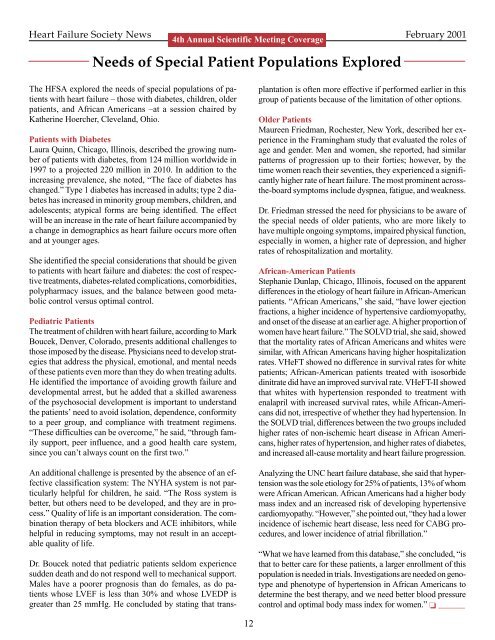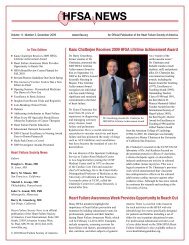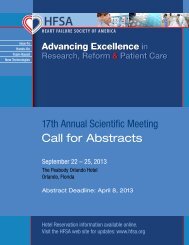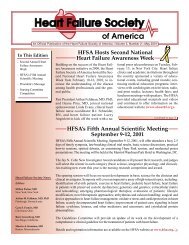Volume 3, Number 1 - Heart Failure Society of America
Volume 3, Number 1 - Heart Failure Society of America
Volume 3, Number 1 - Heart Failure Society of America
Create successful ePaper yourself
Turn your PDF publications into a flip-book with our unique Google optimized e-Paper software.
<strong>Heart</strong> <strong>Failure</strong> <strong>Society</strong> News February 2001<br />
4th Annual Scientific Meeting Coverage<br />
Needs <strong>of</strong> Special Patient Populations Explored<br />
The HFSA explored the needs <strong>of</strong> special populations <strong>of</strong> patients<br />
with heart failure – those with diabetes, children, older<br />
patients, and African <strong>America</strong>ns –at a session chaired by<br />
Katherine Hoercher, Cleveland, Ohio.<br />
Patients with Diabetes<br />
Laura Quinn, Chicago, Illinois, described the growing number<br />
<strong>of</strong> patients with diabetes, from 124 million worldwide in<br />
1997 to a projected 220 million in 2010. In addition to the<br />
increasing prevalence, she noted, “The face <strong>of</strong> diabetes has<br />
changed.” Type 1 diabetes has increased in adults; type 2 diabetes<br />
has increased in minority group members, children, and<br />
adolescents; atypical forms are being identified. The effect<br />
will be an increase in the rate <strong>of</strong> heart failure accompanied by<br />
a change in demographics as heart failure occurs more <strong>of</strong>ten<br />
and at younger ages.<br />
She identified the special considerations that should be given<br />
to patients with heart failure and diabetes: the cost <strong>of</strong> respective<br />
treatments, diabetes-related complications, comorbidities,<br />
polypharmacy issues, and the balance between good metabolic<br />
control versus optimal control.<br />
Pediatric Patients<br />
The treatment <strong>of</strong> children with heart failure, according to Mark<br />
Boucek, Denver, Colorado, presents additional challenges to<br />
those imposed by the disease. Physicians need to develop strategies<br />
that address the physical, emotional, and mental needs<br />
<strong>of</strong> these patients even more than they do when treating adults.<br />
He identified the importance <strong>of</strong> avoiding growth failure and<br />
developmental arrest, but he added that a skilled awareness<br />
<strong>of</strong> the psychosocial development is important to understand<br />
the patients’ need to avoid isolation, dependence, conformity<br />
to a peer group, and compliance with treatment regimens.<br />
“These difficulties can be overcome,” he said, “through family<br />
support, peer influence, and a good health care system,<br />
since you can’t always count on the first two.”<br />
An additional challenge is presented by the absence <strong>of</strong> an effective<br />
classification system: The NYHA system is not particularly<br />
helpful for children, he said. “The Ross system is<br />
better, but others need to be developed, and they are in process.”<br />
Quality <strong>of</strong> life is an important consideration. The combination<br />
therapy <strong>of</strong> beta blockers and ACE inhibitors, while<br />
helpful in reducing symptoms, may not result in an acceptable<br />
quality <strong>of</strong> life.<br />
Dr. Boucek noted that pediatric patients seldom experience<br />
sudden death and do not respond well to mechanical support.<br />
Males have a poorer prognosis than do females, as do patients<br />
whose LVEF is less than 30% and whose LVEDP is<br />
greater than 25 mmHg. He concluded by stating that transplantation<br />
is <strong>of</strong>ten more effective if performed earlier in this<br />
group <strong>of</strong> patients because <strong>of</strong> the limitation <strong>of</strong> other options.<br />
Older Patients<br />
Maureen Friedman, Rochester, New York, described her experience<br />
in the Framingham study that evaluated the roles <strong>of</strong><br />
age and gender. Men and women, she reported, had similar<br />
patterns <strong>of</strong> progression up to their forties; however, by the<br />
time women reach their seventies, they experienced a significantly<br />
higher rate <strong>of</strong> heart failure. The most prominent acrossthe-board<br />
symptoms include dyspnea, fatigue, and weakness.<br />
Dr. Friedman stressed the need for physicians to be aware <strong>of</strong><br />
the special needs <strong>of</strong> older patients, who are more likely to<br />
have multiple ongoing symptoms, impaired physical function,<br />
especially in women, a higher rate <strong>of</strong> depression, and higher<br />
rates <strong>of</strong> rehospitalization and mortality.<br />
African-<strong>America</strong>n Patients<br />
Stephanie Dunlap, Chicago, Illinois, focused on the apparent<br />
differences in the etiology <strong>of</strong> heart failure in African-<strong>America</strong>n<br />
patients. “African <strong>America</strong>ns,” she said, “have lower ejection<br />
fractions, a higher incidence <strong>of</strong> hypertensive cardiomyopathy,<br />
and onset <strong>of</strong> the disease at an earlier age. A higher proportion <strong>of</strong><br />
women have heart failure.” The SOLVD trial, she said, showed<br />
that the mortality rates <strong>of</strong> African <strong>America</strong>ns and whites were<br />
similar, with African <strong>America</strong>ns having higher hospitalization<br />
rates. VHeFT showed no difference in survival rates for white<br />
patients; African-<strong>America</strong>n patients treated with isosorbide<br />
dinitrate did have an improved survival rate. VHeFT-II showed<br />
that whites with hypertension responded to treatment with<br />
enalapril with increased survival rates, while African-<strong>America</strong>ns<br />
did not, irrespective <strong>of</strong> whether they had hypertension. In<br />
the SOLVD trial, differences between the two groups included<br />
higher rates <strong>of</strong> non-ischemic heart disease in African <strong>America</strong>ns,<br />
higher rates <strong>of</strong> hypertension, and higher rates <strong>of</strong> diabetes,<br />
and increased all-cause mortality and heart failure progression.<br />
Analyzing the UNC heart failure database, she said that hypertension<br />
was the sole etiology for 25% <strong>of</strong> patients, 13% <strong>of</strong> whom<br />
were African <strong>America</strong>n. African <strong>America</strong>ns had a higher body<br />
mass index and an increased risk <strong>of</strong> developing hypertensive<br />
cardiomyopathy. “However,” she pointed out, “they had a lower<br />
incidence <strong>of</strong> ischemic heart disease, less need for CABG procedures,<br />
and lower incidence <strong>of</strong> atrial fibrillation.”<br />
“What we have learned from this database,” she concluded, “is<br />
that to better care for these patients, a larger enrollment <strong>of</strong> this<br />
population is needed in trials. Investigations are needed on genotype<br />
and phenotype <strong>of</strong> hypertension in African <strong>America</strong>ns to<br />
determine the best therapy, and we need better blood pressure<br />
control and optimal body mass index for women.” ❏ ______<br />
12
















